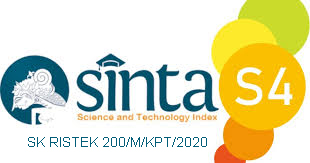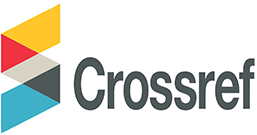ANALYSIS OF THE SHORTEST ROUTE FROM CIKAMPEK TO PURWOKERTO USING ANT COLONY ALGORITHM
Abstract
Finding the shortest path sometimes makes most people confused in choosing a path, especially if there are many paths that must be taken to reach one destination. Tracing various routes from Cikampek to Purwokerto is a challenge, with the risk of spending excessive time and money. To solve this problem, this research uses the Ant Colony Algorithm to determine the most efficient path. One of the problems that often arises is that the Cikampek area has 3 routes that can be used to reach Purwokerto, namely the Cikampek - Indramayu (Patrol), Cikampek - Subang, and Cikampek - Bandung routes. The purpose of determining the shortest path is to provide the shortest path solution to users so that they can reach their destination faster and save time and costs. In this study, we use Ant Algorithm because the route from Cikampek to Purwokerto depends on many road factors and other conditions that could change from time to time. For example, traffic congestion and road repairs are major factors. The ant algorithm has strong customization capabilities to determine the shortest path based on the pheromone trails left by ants during exploration. This means that the ant algorithm can work optimally even if there are many factors in road conditions. In addition, the ant algorithm has the ability to handle problems with a large number of nodes, so it can explore various possibilities efficiently. The ant algorithm is an appropriate choice for finding the shortest path in a journey involving complex and diverse routes. There are six steps required to complete the ant algorithm. The first step is initialization, the second step is path selection, and the third step is setting the ant trail and communication between the ants hit by the trail in path selection. The fourth step is to look for visibility, the fifth step is to stop the criterion until it reaches a certain condition, and the last step is to determine the path by calculating probabilities. The results of this study indicate that the ant algorithm can be used to determine the shortest path which is then displayed. This research aims to assist the community in making decisions and determining the location of the city that must be passed. This study took 8 location points with starting point A and destination point H. Based on the results of the discussion it can be concluded that the shortest route from Cikampek to Purwokerto is with 3 routes, namely first (A à D à E à F à H) with a distance of 355 KM, second (A à D à G à F à H) with a distance of 431 KM and the third (A à D à E àH) with a distance of 317 KM.
Keywords
Full Text:
PDFReferences
Iing Mutakhiroh, Fajar Saptono, Nur Hasanah, Romi Wiryadinata,2007,” Pemanfaatan Metode Heuristik Dalam Pencarian Jalur Terpendek Dengan Algoritma Semut Dan Algoritma Genetika,” ISSN: 1907-5022. Seminar Nasional Aplikasi Teknologi Informasi 2007 (SNATI 2007)
Henri,2018 “Google Maps Adalah Layanan Pemetaan Wilayah Melalui Web, Ketahui Manfaatnya,” Angewandte Chemie International Edition, 6(11), 951–952., 2018.
Ismail, A.A., Herdjunanto, S., 2012. Penerapan algoritma ant system dalam menemukan jalur optimal pada traveling salesman problem (tsp) dengan kekangan kondisi jalan. Jnteti, 1(3),43-47.
dicoding. (2020, July 15). Retrieved from https://www.dicoding.com/blog/kecerdasan-buatan-adalah/ Retrieved from https://lmsspada.kemdikbud.go.id/mod/resource/view.php?id=47638
Munir, R., 2005. Matematika Diskrit. Edisi ketiga. In Bandung: Informatika.
Mutakhiroh, I., Indrato., dan Hidayat, T. Pencarian Jalur Terpendek Menggunakan Algoritma Semut. Seminar Nasional Aplikasi Teknologi Informasi 2007 (SNATI 2007).B-81-B-85. 2007.
Triandi, B., 2012. Penemuan Jalur Terpendek Dengan Algoritma Ant Colony. Csrid, 4(2), 73–80.
Ambarsari, E.W., 2017. Modifikasi algoritma semut untuk optimasi probabilitas pemilihan node dalam penentuan jalur terpendek. Jurnal String, 2(2), 193–200.
Biggs, N., 1986. The traveling salesman problem a guided tour of combinatorial optimization. Bulletin of the London Mathematical Society, 18(5), 514–515.
Bronson, R., 1882. Theory and Problems of Operations Research. New York: McGraw Hill.
Greco, F., 2008. Algoritma semut untuk penyelesaian travelling salesman problem. Jurnal Ilmiah MATRIK 10(2), 183–194.
Ikhsan, J., 2016. Penerapan algoritma semut untuk optimisasi rute penjemputan barang pada tempat jasa penitipan sementara lion express, Jurnal Ilmiah Sarjana Mahasiswa UMRAH, (Vol. 1).
Ismail, A.A., Herdjunanto, S., 2012. Penerapan algoritma ant system dalam menemukan jalur optimal pada traveling salesman problem (tsp) dengan kekangan kondisi jalan. Jnteti, 1(3),43-47.
Nugroho, K., 2015. Penggunaan algoritma semut untuk penentuan optimisasi jalur tim marketing. INFOKAM, 2(9), 92–95.
Putrama, A., Windarto, A.P., 2018. Analisis dalam menentukan produk bri syariah terbaik berdasarkan dana pihak ketiga menggunakan AHP. CESS (Journal of Computer Engineering System and Science), 3(1), 60–64.
Sadewo, M. G., Windarto, A. P., Hartama, D., 2017. Penerapan datamining pada populasi daging ayam ras pedaging di indonesia berdasarkan provinsi menggunakan k-means clustering. Jurnal Nasional Informatika dan Teknologi Jaringan, 2(1), 60–67.
Siregar, M.N.H., 2017. Neural network analysis with backpropogation in predicting human development index ( HDI ) component by regency city in North Sumatera. Internatinal Journal Of Informations Systems and Technologyy (IJISTECH), 1(1), 22–33.
Solikhun, Windarto, A.P., Handrizal, M.Fauzan., 2017. Jaringan saraf tiruan dalam memprediksi sukuk negara ritel berdasarkan kelompok profesi dengan backpropogation dalam mendorong laju pertumbuhan ekonomi. Kumpulan Jurnal Ilmu Komputer (KLIK), 4(2), 184–197.
Sumijan, Windarto, A.P., Muhammad, A., Budiharjo, 2016. Implementation of neural networks in predicting the understanding level of students subject. Internat. Journal of Software Engineering and Its Applications, 10(10), 189–204.
Triandi, B., 2012. Penemuan Jalur Terpendek Dengan Algoritma Ant Colony. Csrid, 4(2), 73–80.
Windarto, A.P., 2017a. Implementation of data mining on rice imports by major country of origin using algorithm using k-means clustering method. International Journal of Artificial Intelligence Research, 1(2), 26–33.
Windarto, A.P., 2017b. Penerapan Data Mining Pada Ekspor Buah-Buahan Menurut Negara Tujuan Menggunakan K-Means Clustering. Techno.COM, 16(4), 348–357.
Windarto, A.P., Dewi, L.S., Hartama, D., 2017. Implementation of artificial intelligence in predicting the value of indonesian oil and gas exports with bp algorithm. International Journal of Recent Trends in Engineering & Research (IJRTER), 3(10), 1–12.
Yuwono, B., Aribowo, A.S., Wardoyo, S.B., 2009. Implementasi algoritma koloni semut pada proses pencarian jalur terpendek jalan protokol di City Yogyakarta. Seminar Nasional Informatika 2009, 111–120.
Zer, P. P. P. A. N. W. F. I. R. H., Windarto, A.P., 2018.
Analisis pemilihan rekomendasi produk terbaik prudential berdasarkan jenis asuransi jiwa berjangka untuk kecelakaan menggunakan metode analytic hierarchy process. Journal of Computer Engineering System and Science 3(1), 78-82.
Zukhri, Z., 2005. Analisis algoritma semut untuk pemecahan masalah penugasan. SNASTI 2005, 47–51.
DOI: https://doi.org/10.31326/jisa.v7i1.1755
Refbacks
- There are currently no refbacks.
Copyright (c) 2024 Mohammad Amin Tohari, Fauzan Cholis Ar rasyid, Muhammad Husni, Zidhan Arrasyid, Thorik Agung Prakoso, Dasril Aldo

This work is licensed under a Creative Commons Attribution-ShareAlike 4.0 International License.
JOURNAL IDENTITY
Journal Name: JISA (Jurnal Informatika dan Sains)
e-ISSN: 2614-8404, p-ISSN: 2776-3234
Publisher: Program Studi Teknik Informatika Universitas Trilogi
Publication Schedule: June and December
Language: English
APC: The Journal Charges Fees for Publishing
Indexing: EBSCO , DOAJ, Google Scholar, Arsip Relawan Jurnal Indonesia, Directory of Research Journals Indexing, Index Copernicus International, PKP Index, Science and Technology Index (SINTA, S4) , Garuda Index
OAI address: http://trilogi.ac.id/journal/ks/index.php/JISA/oai
Contact: jisa@trilogi.ac.id
Sponsored by: DOI – Digital Object Identifier Crossref, Universitas Trilogi
In Collaboration With: Indonesian Artificial Intelligent Ecosystem(IAIE), Relawan Jurnal Indonesia, Jurnal Teknologi dan Sistem Komputer (JTSiskom)
JISA (Jurnal Informatika dan Sains) is Published by Program Studi Teknik Informatika, Universitas Trilogi under Creative Commons Attribution-ShareAlike 4.0 International License.


















